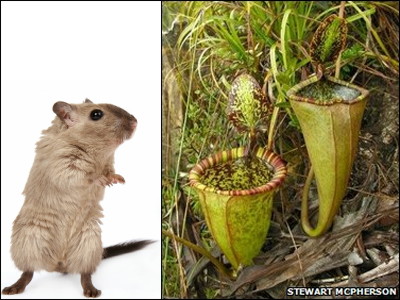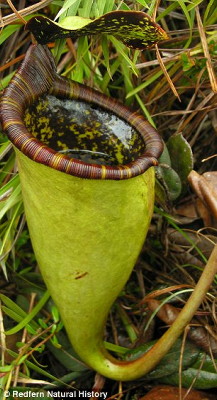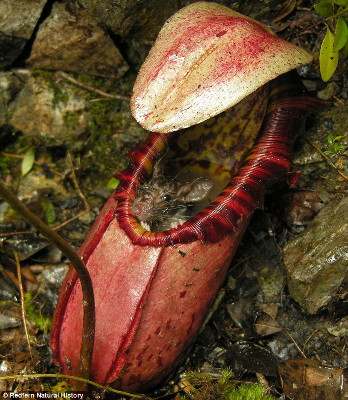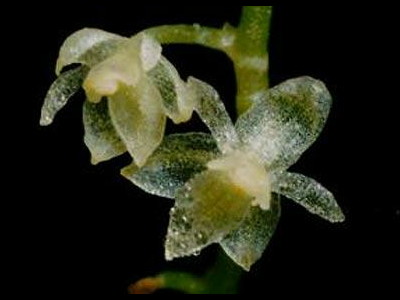Meat eating that will melt the rats, huge carnivorous plant found in the Philippines

British explorer team Philippines ·Palawan ProvinceWhile exploring Mt. Victoria,RodentA huge new species that can captureUboppoldIt seems he found out.
Speaking of Utsboru Kazura is a representative insecticidal plant that captures insects in traps like pitfalls, makes it drows, then slowly dissolves it with digestive enzymes and nourishes it, but if it is so large it is suitable for meat plants anymore maybe.
Details are as below. (* Please be careful as there may be some images grotesque and felt)Rat-eating plant named after David Attenborough | Mail Online
Rat-eating plant discovered in Philippines - Telegraph
BBC - Earth News - Giant 'meat - eating' plant found
Mr. Stewart McPherson (26 years old), a British natural historian, and a team of botanists Alastair Robinson and Philippine Volker Heinrich said that two missionaries who were distressed for 13 days in 2000 to try to climb Mount Victoria had giant Uzbekazura On the basis of a sighting story that I saw it, I began exploring for 2 months aiming to climb Mount Victoria and discover this plant in 2007. Both of them are experts of Uruborukazura, and he seems to have experienced trekking the outback of the world in search of new varieties of plants.
Mount Victoria.

Departing with team formation of six people including three guides, when passing through the forest at the foot of the mountainNepenthes philippinensisIn addition to observing the population of Urukobazura called, I heard that they also found pink ferns and blue mushrooms that have new possibilities.

The forest narrowed as it approached the summit, a line that reached the area covered with rocks and shrubs. "A sudden one giant beetle entered the eyes at an altitude of 1,600 meters, and it appeared one after another, two, three," Mr. McPherson recalls. "At the moment of discovery, it was clear that this plant is a new species that has not been known before."
According to McPherson, Utosukobazura seems to need to take nutrients from animals (primarily insects) in order to grow in such a harsh environment that nutrients can not be obtained from the soil. The insect trap has a vivid color to attract insects and secretes honey. The attracted insects and small animals slide down into a pot-shaped part filled with digestive juice, struggling exhausted or drowning, after being died, it is dissolved with acid or enzyme, and in most cases only bones are left.
The insect trap of Beijing Kuzura discovered this time is a vivid green and purplish spots, clearly emerging from surrounding vegetation. Growing to Borneo from the shape of flowers and leavesNepenthes RajahIt seems that there is connection with Nepenthes flora distributed in neighboring Palawan Province and Borneo.

Growing in BorneoNepenthes northianaIt is like digesting mice.

The team put the reference specimens of this new species of Uruborukazu in the plant specimen collection of Palawan State University, and the botanistSir David AttenboroughNamed after "Nepenthes attenboroughii". Lord Attenborough who received the consultation from the team "I wonder if you can give me a name named after you" was deeply moved and said she responded promptly as "Thank you".
Lord Attenborough, also famous as a moderator for television's natural program, is 83 years old. "It is the greatest and most amazing seed of these plants, I think it is a very honorable thing."

"The plants we found this time are among the largest species of carnivorous plants and the insects can catch not only insects but also rodent species as large as rats until the 21st century It was surprising that it was not there, McPherson said. The details of this discoveryDorset StateProduction company operated by McPherson in the poolRedfern Natural HistoryIn addition to documentation being under way by, it seems that it is also booked.
In addition, the team is still a carnivorous plant in the descending mountainWelsh onionWe also discovered a new species of it, it is currently being prepared for formal registration. Also, in 1945, the only specimen was lost in the fire, the sea cucumber that was not observed in the wild for the past 100 yearsNepenthes deanianaIt seems that it was a very fruitful expedition because it was able to see.
Related Posts:
in Science, Posted by darkhorse_log







